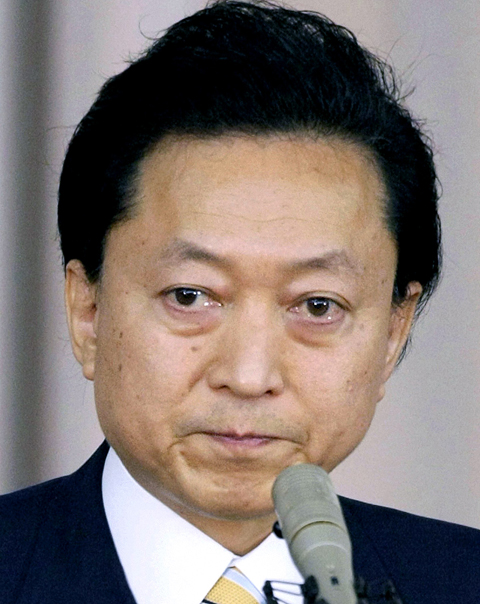Japanese Prime Minister Yukio Hatoyama tearfully resigned yesterday, just nine months after a stunning election win, his brief reign derailed by a row over an unpopular US airbase.
Hatoyama ended more than half a century of conservative rule in an electoral earthquake in August, but soon earned a reputation for crippling indecision at the helm of the world’s second-biggest economy.
The 63-year-old millionaire, the scion of an influential family dubbed “Japan’s Kennedys,” quit at a meeting of his Democratic Party of Japan (DPJ), blaming the base dispute and political funding scandals.

PHOTO: REUTERS
“I will step down,” an emotional Hatoyama told party lawmakers at a special meeting in parliament, while also vowing to “create a new DPJ.”
“I apologize to all of you lawmakers here for causing enormous trouble,” he said.
Japanese Finance Minister Naoto Kan, 63, who is deputy prime minister, was widely tipped to succeed Hatoyama and in the afternoon declared his intention to take over the party leadership in a vote tomorrow.
Kan, a former grassroots civic activist, achieved popularity in the mid-1990s when as health minister he admitted government culpability in a scandal over HIV-tainted blood products.
The new DPJ chief must be elected prime minister by parliament in a vote expected later tomorrow. On Monday, the new prime minister is expected to give a policy address and formally launch his new Cabinet, said the DPJ.
Speculation had swirled for days that Hatoyama would quit as his approval ratings, once above 70 percent, crashed below the 20 percent mark.
His rapid demise since he took office in mid-September was driven by the festering dispute over a US Marine Corps airbase on Okinawa island that badly strained ties with the US, Tokyo’s bedrock ally.
Hatoyama, a Stanford-trained engineering academic, took power vowing less subservient ties with Washington and closer engagement with Asia, worrying many Japan watchers in the US.
He promised to move the US base off Okinawa, to ease the burden for locals who have long complained of aircraft noise, pollution and crime associated with a heavy US military presence since World War II.
However, after failing to find an alternative location for the base in Japan, he backtracked and decided to keep it on the island, enraging Okinawans and his pacifist coalition partners the Social Democrats.
The left-leaning group quit his three-party coalition on Sunday, weakening the government in parliament’s upper house ahead of elections for the chamber expected on July 11, in which the DPJ expects to take a beating.
The DPJ’s most influential figure, Secretary General Ichiro Ozawa, quit after Hatoyama asked him to step down. Both men have been embroiled in political funding scandals.
Hatoyama’s wealthy mother handed large donations to his electoral war chest, triggering a criminal investigation that saw a close aide receive suspended jail terms.
Hatoyama said the funding scandals and the Okinawa issue were the main reasons for his demise.

LIMITS: While China increases military pressure on Taiwan and expands its use of cognitive warfare, it is unwilling to target tech supply chains, the report said US and Taiwan military officials have warned that the Chinese People’s Liberation Army (PLA) could implement a blockade within “a matter of hours” and need only “minimal conversion time” prior to an attack on Taiwan, a report released on Tuesday by the US Senate’s China Economic and Security Review Commission said. “While there is no indication that China is planning an imminent attack, the United States and its allies and partners can no longer assume that a Taiwan contingency is a distant possibility for which they would have ample time to prepare,” it said. The commission made the comments in its annual

DETERMINATION: Beijing’s actions toward Tokyo have drawn international attention, but would likely bolster regional coordination and defense networks, the report said Japanese Prime Minister Sanae Takaichi’s administration is likely to prioritize security reforms and deterrence in the face of recent “hybrid” threats from China, the National Security Bureau (NSB) said. The bureau made the assessment in a written report to the Legislative Yuan ahead of an oral report and questions-and-answers session at the legislature’s Foreign Affairs and National Defense Committee tomorrow. The key points of Japan’s security reforms would be to reinforce security cooperation with the US, including enhancing defense deployment in the first island chain, pushing forward the integrated command and operations of the Japan Self-Defense Forces and US Forces Japan, as

‘TROUBLEMAKER’: Most countries believe that it is China — rather than Taiwan — that is undermining regional peace and stability with its coercive tactics, the president said China should restrain itself and refrain from being a troublemaker that sabotages peace and stability in the Indo-Pacific region, President William Lai (賴清德) said yesterday. Lai made the remarks after China Coast Guard vessels sailed into disputed waters off the Senkaku Islands — known as the Diaoyutai Islands (釣魚台) in Taiwan — following a remark Japanese Prime Minister Sanae Takaichi made regarding Taiwan. Takaichi during a parliamentary session on Nov. 7 said that a “Taiwan contingency” involving a Chinese naval blockade could qualify as a “survival-threatening situation” for Japan, and trigger Tokyo’s deployment of its military for defense. Asked about the escalating tensions

The Ministry of Economic Affairs said it plans to revise the export control list for strategic high-tech products by adding 18 items under three categories — advanced 3D printing equipment, advanced semiconductor equipment and quantum computers — which would require local manufacturers to obtain licenses for their export. The ministry’s announcement yesterday came as the International Trade Administration issued a 60-day preview period for planned revisions to the Export Control List for Dual Use Items and Technology (軍商兩用貨品及技術出口管制清單) and the Common Military List (一般軍用貨品清單), which fall under regulations governing export destinations for strategic high-tech commodities and specific strategic high-tech commodities. The